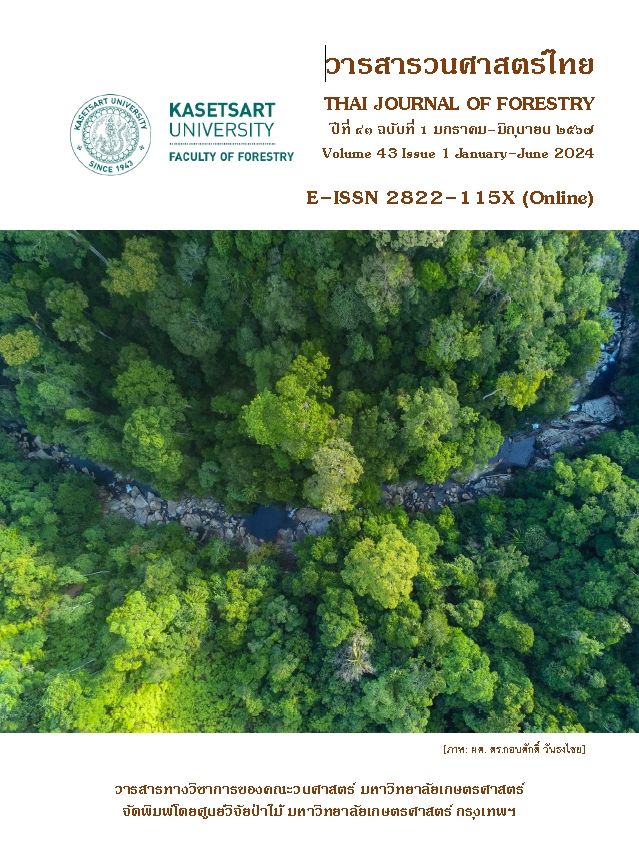ความอุดมสมบูรณ์ของดินและการประเมินการกักเก็บคาร์บอนในพื้นที่ป่าฟื้นฟู 8 ปี จังหวัดแพร่
Main Article Content
บทคัดย่อ
การศึกษาความอุดมสมบูรณ์ของดินและการประเมินการกักเก็บคาร์บอนในพื้นที่ป่าฟื้นฟู 8 ปี บ้านบุญแจ่ม ตำบลน้ำเลา อำเภอร้องกวาง จังหวัดแพร่ โดยการศึกษาครั้งนี้มีวัตถุประสงค์เพื่อศึกษาสมบัติดินและปริมาณการกักเก็บคาร์บอนเพื่อนำมาวิเคราะห์ความสัมพันธ์ของปัจจัยดินที่มีผลต่อการปรากฏของพรรณไม้ ทำการเก็บข้อมูลดินชั้นบนที่ระดับความลึก 0-5 เซนติเมตร ดินชั้นล่างที่ระดับความลึก 20-25 เซนติเมตร บริเวณป่าฟื้นฟู หย่อมป่า และพื้นที่เกษตร เก็บตัวอย่างดินพื้นที่ละ 3 จุด จากนั้นวางแปลงขนาด 40 เมตร x 40 เมตร พร้อมทั้งเก็บองค์ประกอบของชนิดไม้ต้นในป่าฟื้นฟู จำนวน 5 แปลง และหย่อมป่า จำนวน 3 แปลง เพื่อประเมินการกักเก็บคาร์บอนของพรรณไม้ในพื้นที่
ผลการศึกษาพบว่า ดินชั้นบน ค่า pH ของพื้นที่หย่อมป่าเป็นปานกลาง มีค่าเท่ากับ 6.77 ความสามารถในการแลกเปลี่ยนประจุบวก ในพื้นที่หย่อมป่ามีค่ามากที่สุด เท่ากับ 12.5 มิลลิอิควิวาเลนท์/100 กรัม และปริมาณอินทรียวัตถุของในพื้นที่หย่อมป่าและป่าฟื้นฟูมีค่าสูงกว่าพื้นที่เกษตร เท่ากับ 6.65, 5.47 และ 5.02 เปอร์เซ็นต์ ตามลำดับ ธาตุอาหารหลักและธาตุอาหารรองพบหย่อมป่ามีค่าสูงที่สุด ในดินชั้นล่าง สมบัติดินทางเคมีไม่มีความแตกต่างจากดินชั้นบนมากนัก โดยเฉพาะสมบัติดินทางกายภาพไม่แตกต่างกันอย่างมีนัยสำคัญทางสถิติที่ระดับ 95 เปอร์เซ็นต์ ในส่วนของการประเมินการกักเก็บคาร์บอนในพื้นที่ป่าฟื้นฟู พบมวลชีวภาพ 216.45 ตันต่อเฮกตาร์ มีปริมาณการกักเก็บคาร์บอนในมวลชีวภาพ เท่ากับ 101.72 ตันคาร์บอนต่อเฮกตาร์ และหย่อมป่ามีมวลชีวภาพ เท่ากับ 406.78 ตันต่อเฮกตาร์ ปริมาณการกักเก็บคาร์บอนในมวลชีวภาพ เท่ากับ 191.17 ตันคาร์บอนต่อเฮกตาร์ เมื่อเปรียบเทียบในพื้นที่อื่น ๆ พบว่าปริมาณการกักเก็บคาร์บอนมักขึ้นอยู่กับจำนวนและขนาดของไม้ต้น นอกเหนือจากนั้นดินในพื้นที่ป่าฟื้นฟูมีแนวโน้มความอุดมสมบูรณ์มากขึ้น ซึ่งข้อมูลที่ได้จะสามารถเป็นแนวทางในการจัดการพื้นที่ป่าฟื้นฟู และการใช้ประโยชน์พื้นที่อย่างเหมาะสมเพื่อประสิทธิภาพในการกักคาร์บอนที่เพิ่มขึ้นในอนาคต
Downloads
Article Details

อนุญาตภายใต้เงื่อนไข Creative Commons Attribution-NonCommercial-NoDerivatives 4.0 International License.
ข้าพเจ้าและผู้เขียนร่วม (ถ้ามี) ขอรับรองว่า ต้นฉบับที่เสนอมานี้ยังไม่เคยได้รับการตีพิมพ์และไม่ได้อยู่ในระหว่างกระบวนการพิจารณาตีพิมพ์ลงในวารสารหรือสิ่งตีพิมพ์อื่นใด ข้าพเจ้าและผู้เขียนร่วม (ถ้ามี) ยอมรับหลักเกณฑ์และเงื่อนไขการพิจารณาต้นฉบับ ทั้งยินยอมให้กองบรรณาธิการมีสิทธิ์พิจารณาและตรวจแก้ต้นฉบับได้ตามที่เห็นสมควร พร้อมนี้ขอมอบลิขสิทธิ์ผลงานที่ได้รับการตีพิมพ์ให้แก่วารสารวนศาสตร์ คณะวนศาสตร์ มหาวิทยาลัยเกษตรศาสตร์ กรณีมีการฟ้องร้องเรื่องการละเมิดลิขสิทธิ์เกี่ยวกับภาพ กราฟ ข้อความส่วนใดส่วนหนึ่ง หรือ ข้อคิดเห็นที่ปรากฏในผลงาน ให้เป็นความรับผิดชอบของข้าพเจ้าและผู้เขียนร่วม (ถ้ามี) แต่เพียงฝ่ายเดียว และหากข้าพเจ้าและผู้เขียนร่วม (ถ้ามี) ประสงค์ถอนบทความในระหว่างกระบวนการพิจารณาของทางวารสาร ข้าพเจ้าและผู้เขียนร่วม (ถ้ามี) ยินดีรับผิดชอบค่าใช้จ่ายทั้งหมดที่เกิดขึ้นในกระบวนการพิจารณาบทความนั้น”
เอกสารอ้างอิง
Boontoon, P., Suanpaga, W., Maelim, S. 2020. Estimation of carbon stock value of woody plants in mixed deciduous forest in Erawan National Park, Kanchanaburi Province. Thai Journal of Forestry, 39(2): 27-40. (in Thai)
Fongthiwong, W., Lattirasuvan, T., Yothapakdee, T., Chuesaard, T., Chaimongkhon, S. 2022. Ecological characteristics of miang tea gardens (Camellia sinensis (L.). Khon Kaen Agriculture Journal, 49(6): 1351-1363. (in Thai)
Kutintara, U. 2008. Vegetative cover types classification system of Thailand. Journal of Tropical Plants Research, 1-21. (in Thai)
Land Development Department. 2013. A Set of Half-Century Knowledge Soil of Thailand. Ministry of Agriculture and Cooperatives, Bangkok, Thailand. (in Thai)
Land Development Department. 2015. State of Soil and Land Resources of Thailand. The Agricultural Cooperative Federation of Thailand, Limited, Bangkok, Thailand. (in Thai)
Maosew, K., Thanacharoenchanaphas, K., Boonyanuphap, J. 2019. Valuation of carbon stock in undisturbed natural forest and mixed fruit tree-based agroforestry system by landslide and under natural succession. Thai Journal of Forestry, 38(1): 81-95. (in Thai)
Massaccesi, L., Feudis, M.D., Leccese, A., Agnell, A. 2020. Altitude and vegetation affect soil organic carbon, basal respiration and microbial biomass in Apennine forest soils. Forests, 11: 710. doi.org/10.3390/f11060710
Ogawa, H., Yoda, K., Kira, T. 1965. A preliminary survey on the vegetation of Thailand. Nature and life in SE Asia, 1: 21-157.
Sakurai, K., Puriyakorn, B., Preechapanya, P., Tanpibal, V., Muangnil, K., Prachaiyo, B. 1995. Improvement of biological productivity in degraded lands in Thailand III. Tropics, 4 (2/3): 151-172.
Sellan, G., Thompson, J., Majalap, N., Brearley, Q.F. 2019. Soil characteristics influence species composition and forest structure differentially among tree size classes in a Bornean heath forest. Plant Soil, 438(9): 173–185.
Shewchenko, O., Asanok, L., Marod, D. 2018. Forest structure and species composition of limestone forest after mining, Phrae province. Thai Journal of Forestry, 37 (1): 73-83 (in Thai)
Srethasirote, B., Tawon, R., Poangjit, L., Soontornwong, S. 2011. REDPLUS: Hot Issues in the World Negotiation Arena Concepts and Formats Appropriate for Thai Society. Dhammarath Institute for Social and Environmental Development, Bangkok, Thailand. (in Thai)
Thailand Greenhouse Gas Management Organization (Public Organization) (TGO). 2016. Thailand Voluntary Emission Reduction Program Reference Manual: Forestry and Agriculture Sector, 3rd ed. Thailand Greenhouse Gas Management Organization (Public Organization), Bangkok, Thailand. (in Thai)
The Intergovernmental Panel on Climate Change (IPCC). 2006. Guidelines for National Greenhouse Gas Inventories: Chapter 4 Forest Land. https://www. Ipcc-nggip.iges.or.jp/public/2006gl/pdf/4_Volume4/V4_04_Ch4_Forest_Land.pdf, 28 August 2023.
Wanichanukul, S., Chuenwong, P., Chantima,K., Sukueng, K., Pinmongkhonkul, S. 2022. The carbon sequestration of plant community in plantation forest in Pa Doi Bo National Forest Reserves, Chiang Rai province. Journal of Interdisciplinary Research, 11(2): 157-167. (in Thai)
Wiriyakitnatekul, W., Kerdchana, C. 2016. Methods of Soil Analysis and Interpretation for Soil Survey and Classification: Physical Properties. Office of Science for Land Development Land Development Department. Bangkok, Thailand. (in Thai)


